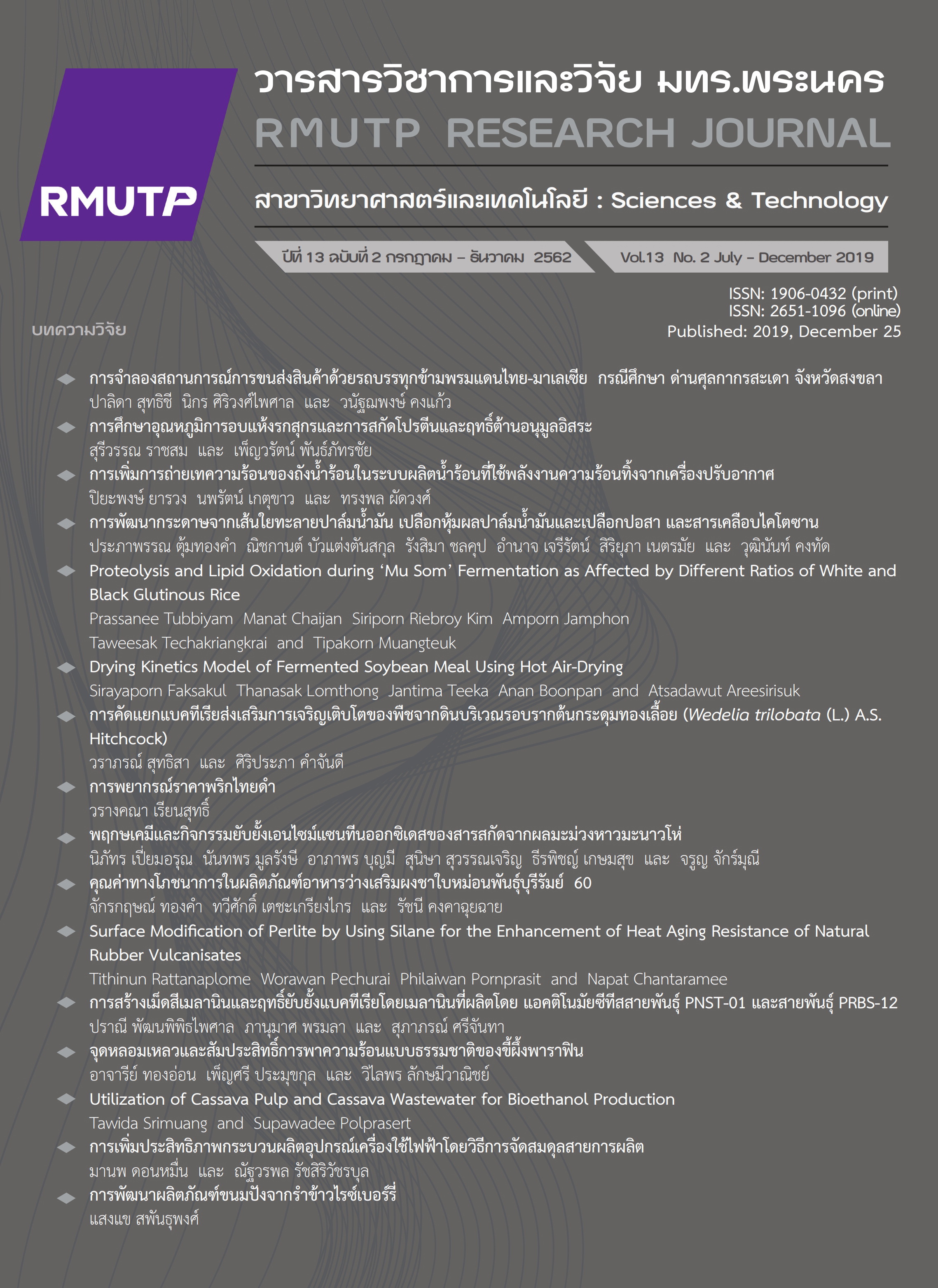Isolation and Selection of Plant Growth Promoting Rhizobacteria from Wedelia trilobata (L.) A.S. Hitchcock Rhizosphere
Main Article Content
Abstract
The objective of this research was to isolate plant growth promoting rhizobacteria from Wedelia trilobata (L.) A.S. Hitchcock and test their basic properties of plant growth promoters. Forty-seven bacteria isolates were obtained including 26 isolates of gram positive, 18 isolates of gram negative and 3 isolates of actinobacteria. Plant growth promoting properties were tested such as nitrogen fixation, siderophore production, phosphate solubilization and indole-3-acetic acid production. After that 8 isolates were selected for studying of root colonization and plant growth promoting properties including BWTM1_MSU, BWTM2_MSU, BWTM5_MSU, BWTM6_MSU, BWWM6_MSU, BWWM8_MSU, BWWM9_MSU and BWWM16_MSU. The results show that BWTM5_MSU evident promote plant growth with the most seed germination (63.33%), high level of root and shoot length with 6.11 cm and 3.89 cm, respectively. As a result, the root and shoot weight was as high as 9.56 mg and 11.33 mg, respectively. It also correlated with the highest production of indole-3-acetic acid up to 421.29 ug/ml. Seven days after sowing, can isolated BWTM5_MSU from rhizoplane and rhizosphere with 9.67x106 cfu/ml and 1.64x1010 cfu/ml, respectively.
Article Details
References
[2] A. Kumar, V. Dana, M.K. Singh, P.P. Ratap, S.S.D. Kumar, S.P. Kumar, S. Kapil and D. Pandey, “Isolation of plant growth promoting rhizobacteria and their impact on growth and curcumin content in Curcuma longa L.,” Biocatalysis and Agricultural Biotechnology, vol. 8, pp.1 – 7, Oct. 2016.
[3] D. Thakur, M. Kaur and A. Mishra, “Isolation and screening of plant growth promoting Bacillus spp. and Pseudomonas spp. and their effect on growth, rhizospheric population and phosphorous concentration of Aloe vera,” Journal of Medicinal Plants Studies, vol. 5, no. 1, pp.187 – 192, Jan. 2017.
[4] J.P. Dubey and A.N. Hamir, “Experimental toxoplasmosis in budgerigars (Melopsittacus undulates),” Journal of Parasitol, vol. 88, no.3, pp. 514– 519, Jan. 2002.
[5] U.P. Shrivastava and A. Kumar, “A simple and rapid plate assay for the screening of indole-3-Acetic acid (IAA) producing microorganisms,” International Journal of Applied Biology and Pharmaceutical Technology, vol.2, no.1, pp. 120-123, Jan. 2011.
[6] E. Bharucha, J.H. Pemberton and G.L. Richard, “American gastroenterological association technical review on constipation,” Gastroenterology, vol.144, no. 1, pp. 218-238, Jan. 2013.
[7] K. Soderberg, A. Probanza, A. Jumpponen and E. Baath, “The microbial community in the rhizosphere determined by community-level physiologicalprofiles (CLPP) and direct soil and cfu-PLFA technique, Applied Soil Ecology, vol. 25, no. 2, pp. 135–145, Feb. 2004.
[8] R. Dick, Lecture on Soil Bacteria in Soil Microbiology, The Ohio State University School of Environment and Natural Resources, Columbus, Ohio, 2009.
[9] S. Bakthavatchalu and S. Shivakumar, “Siderophore production by Pseudomonas aeruginosa FP6, a biocontrol strain for Rhizoctonia solani and Colletotrichum gloeosporioides causing diseases in chilli,” Agriculture and Natural Resources, vol. 50, no. 4, pp. 250-256, July 2016.
[10] K. Kanimozhi and A. Panneerselvam, “Studies on isolation and nitrogen fixation ability of Azospirillum spp. isolated from Thanjavur district.,” Pelagia Research Library, vol.1, no.3, pp. 138- 145, 2010.
[11] T. Fang, D. Yangin, Z. Hui, Y. Liangtog and D. Binghai, “Genetic diversity of siderophore-producing bacteria of tobacco rhizosphere,” Brazilian Journal of Microbiology, vol. 40, no.2 pp. 276-284, Apr.-Jun. 2009.
[12] A. Grobelak, A. Napora and M. Kacprzak, “Using plant growth-promoting rhizobacteria (PGPR) to improve plant Growth. Ecological Engineering, vol. 8, no. 4, pp. 22 – 28, Nov. 2015.


